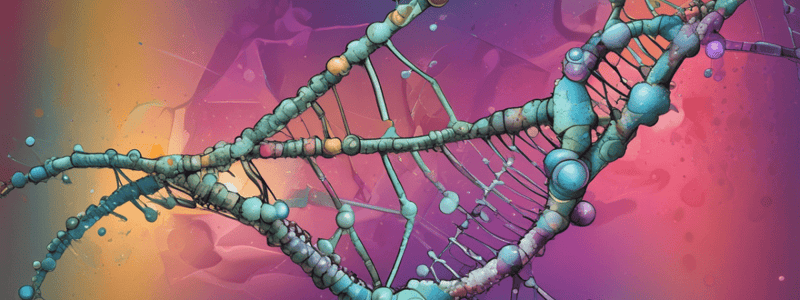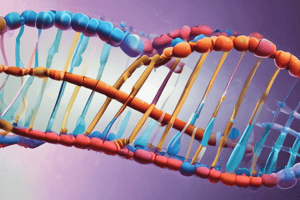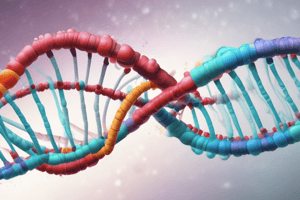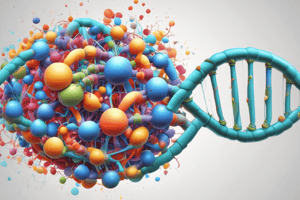Podcast
Questions and Answers
What was the major challenge to biologists in the 20th century?
What was the major challenge to biologists in the 20th century?
- To study the behavior of chromosomes
- To identify the molecules of inheritance (correct)
- To understand the process of protein synthesis
- To understand the structure of DNA
What were the two components of chromosomes that were candidates for the genetic material?
What were the two components of chromosomes that were candidates for the genetic material?
- Nucleotides and amino acids
- Lipids and carbohydrates
- DNA and protein (correct)
- RNA and protein
What was the initial reason why protein was a stronger candidate than DNA for the genetic material?
What was the initial reason why protein was a stronger candidate than DNA for the genetic material?
- Protein was more easily visible under a microscope
- Protein was more abundant in cells
- Protein was seen as more complex and likely to contain genetic information (correct)
- Protein was easier to isolate
What characteristics did the genetic material need to have?
What characteristics did the genetic material need to have?
Which organisms were studied to first discover the role of DNA in heredity?
Which organisms were studied to first discover the role of DNA in heredity?
What is the process of creating a copy of DNA called?
What is the process of creating a copy of DNA called?
What is the name of the scientists who contributed to the discovery of the structure of DNA?
What is the name of the scientists who contributed to the discovery of the structure of DNA?
What is the name of the chapter in Campbell Biology that discusses DNA structure and function?
What is the name of the chapter in Campbell Biology that discusses DNA structure and function?
What is the result of a condensation reaction in DNA synthesis?
What is the result of a condensation reaction in DNA synthesis?
What is the shape of a bacterial chromosome?
What is the shape of a bacterial chromosome?
Where are eukaryotic chromosomes located?
Where are eukaryotic chromosomes located?
What is the function of histone H1?
What is the function of histone H1?
What is the structure of a nucleosome?
What is the structure of a nucleosome?
What is the term for loosely packed chromatin that enables gene expression?
What is the term for loosely packed chromatin that enables gene expression?
During which stage of the cell cycle is chromatin highly condensed?
During which stage of the cell cycle is chromatin highly condensed?
What is the purpose of histone modification in chromatin structure?
What is the purpose of histone modification in chromatin structure?
What is the shape of the E. coli chromosome?
What is the shape of the E. coli chromosome?
How many origins of replication do eukaryotic chromosomes have?
How many origins of replication do eukaryotic chromosomes have?
What is the function of helicases during DNA replication?
What is the function of helicases during DNA replication?
What is the function of single-strand binding protein during DNA replication?
What is the function of single-strand binding protein during DNA replication?
What is the direction of nucleotide addition by DNA polymerases?
What is the direction of nucleotide addition by DNA polymerases?
What is the purpose of topoisomerase during DNA replication?
What is the purpose of topoisomerase during DNA replication?
What is the limitation of DNA polymerases in terms of initiation of replication?
What is the limitation of DNA polymerases in terms of initiation of replication?
What is the shape of the region at the end of each replication bubble where new DNA strands are elongating?
What is the shape of the region at the end of each replication bubble where new DNA strands are elongating?
What is the role of primase in DNA replication?
What is the role of primase in DNA replication?
What is the direction of DNA synthesis by DNA polymerase?
What is the direction of DNA synthesis by DNA polymerase?
What is the purpose of the RNA primer in DNA replication?
What is the purpose of the RNA primer in DNA replication?
What is the difference between dATP and ATP?
What is the difference between dATP and ATP?
What is the function of DNA ligase in DNA replication?
What is the function of DNA ligase in DNA replication?
What is the direction of leading strand synthesis?
What is the direction of leading strand synthesis?
What is the function of the sliding clamp in DNA replication?
What is the function of the sliding clamp in DNA replication?
What is the result of the modified 3’-OH group in AZT?
What is the result of the modified 3’-OH group in AZT?
What is the role of primase during DNA replication?
What is the role of primase during DNA replication?
Which enzyme is responsible for adding DNA nucleotides to each primer in the 5'→3' direction?
Which enzyme is responsible for adding DNA nucleotides to each primer in the 5'→3' direction?
What is the direction of DNA synthesis during lagging strand synthesis?
What is the direction of DNA synthesis during lagging strand synthesis?
What is the purpose of DNA ligase during DNA replication?
What is the purpose of DNA ligase during DNA replication?
What happens to the RNA primer after DNA pol III reaches the next RNA primer?
What happens to the RNA primer after DNA pol III reaches the next RNA primer?
What is the role of DNA polymerase I during DNA replication?
What is the role of DNA polymerase I during DNA replication?
What is the overall direction of replication during lagging strand synthesis?
What is the overall direction of replication during lagging strand synthesis?
What is the purpose of Okazaki fragments during DNA replication?
What is the purpose of Okazaki fragments during DNA replication?
What is the primary function of histone H1 in chromatin structure?
What is the primary function of histone H1 in chromatin structure?
What is the term for the highly condensed form of chromatin that inhibits gene expression?
What is the term for the highly condensed form of chromatin that inhibits gene expression?
During which stage of the cell cycle is most chromatin in a loosely packed form?
During which stage of the cell cycle is most chromatin in a loosely packed form?
What is the diameter of the 30-nm chromatin fiber?
What is the diameter of the 30-nm chromatin fiber?
What is the result of a condensation reaction in DNA synthesis?
What is the result of a condensation reaction in DNA synthesis?
What is the structure of a nucleosome?
What is the structure of a nucleosome?
What is the purpose of nucleosomes in chromatin structure?
What is the purpose of nucleosomes in chromatin structure?
What is the structure of the chromatin fiber that is 10 nm in diameter?
What is the structure of the chromatin fiber that is 10 nm in diameter?
What is the type of sugar found in DNA nucleotides?
What is the type of sugar found in DNA nucleotides?
What is the bond that holds the two strands of DNA together?
What is the bond that holds the two strands of DNA together?
What is the direction of the sugar-phosphate backbone in a DNA molecule?
What is the direction of the sugar-phosphate backbone in a DNA molecule?
What is the purpose of the nitrogenous bases in DNA?
What is the purpose of the nitrogenous bases in DNA?
What is the base pairing rule described by Watson and Crick?
What is the base pairing rule described by Watson and Crick?
What is the term for the equal number of A and T bases, and G and C bases in any species?
What is the term for the equal number of A and T bases, and G and C bases in any species?
What is the shape of the DNA molecule described by Watson and Crick?
What is the shape of the DNA molecule described by Watson and Crick?
What is the function of the phosphate group in a DNA nucleotide?
What is the function of the phosphate group in a DNA nucleotide?
What is the primary function of DNA polymerases during replication?
What is the primary function of DNA polymerases during replication?
What type of DNA damage is caused by UV light and X-rays?
What type of DNA damage is caused by UV light and X-rays?
What is the primary function of mismatch repair (MMR)?
What is the primary function of mismatch repair (MMR)?
What is the name of the process by which DNA polymerases correct mismatched nucleotides during replication?
What is the name of the process by which DNA polymerases correct mismatched nucleotides during replication?
What is the term for the type of DNA lesion that is repaired by nucleotide excision repair (NER)?
What is the term for the type of DNA lesion that is repaired by nucleotide excision repair (NER)?
What is the direction of the exonuclease activity of DNA polymerases during proofreading?
What is the direction of the exonuclease activity of DNA polymerases during proofreading?
What is the primary function of base excision repair (BER)?
What is the primary function of base excision repair (BER)?
What is the result of DNA polymerases' proofreading and exonuclease activity during replication?
What is the result of DNA polymerases' proofreading and exonuclease activity during replication?
What is the main consequence of Xeroderma pigmentosum?
What is the main consequence of Xeroderma pigmentosum?
What is the type of DNA damage caused by UV light?
What is the type of DNA damage caused by UV light?
Which repair mechanism is responsible for repairing thymine dimers?
Which repair mechanism is responsible for repairing thymine dimers?
What is the genetic disorder caused by a mutation in the genes encoding for the NER repair enzymes?
What is the genetic disorder caused by a mutation in the genes encoding for the NER repair enzymes?
Which type of DNA damage is repaired by the MMR repair mechanism?
Which type of DNA damage is repaired by the MMR repair mechanism?
What is the type of DNA repair mechanism that is inactive in Xeroderma pigmentosum patients?
What is the type of DNA repair mechanism that is inactive in Xeroderma pigmentosum patients?
What is the result of the inactivation of the NER repair mechanism in Xeroderma pigmentosum patients?
What is the result of the inactivation of the NER repair mechanism in Xeroderma pigmentosum patients?
Which type of DNA damage is caused by chemicals?
Which type of DNA damage is caused by chemicals?
What is the result of DNA replication according to the semiconservative model?
What is the result of DNA replication according to the semiconservative model?
What is the purpose of origins of replication in DNA replication?
What is the purpose of origins of replication in DNA replication?
How many origins of replication can a eukaryotic chromosome have?
How many origins of replication can a eukaryotic chromosome have?
What is the direction of replication from each origin?
What is the direction of replication from each origin?
What is the structure of the newly synthesized DNA molecule during replication?
What is the structure of the newly synthesized DNA molecule during replication?
What is the result of the separation of DNA strands during replication?
What is the result of the separation of DNA strands during replication?
What is the significance of the semiconservative model of DNA replication?
What is the significance of the semiconservative model of DNA replication?
What is the characteristic of DNA replication that makes it a fast and highly accurate process?
What is the characteristic of DNA replication that makes it a fast and highly accurate process?
Flashcards are hidden until you start studying




